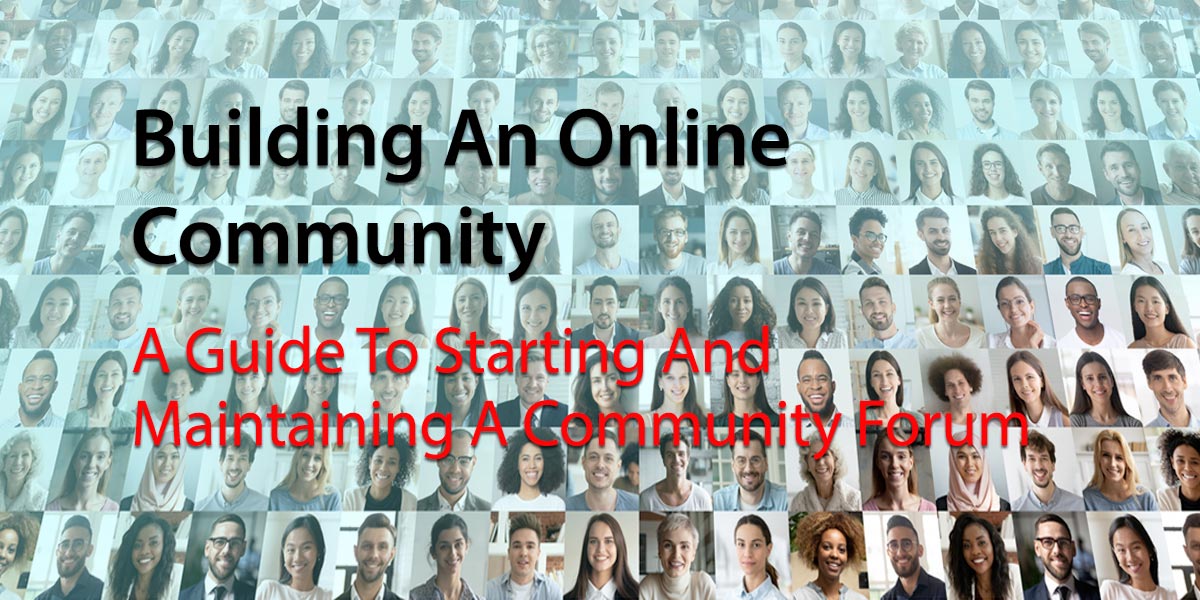Want to build stronger relationships with existing and potential customers 24/7? It’s a no-brainer, right? Increasingly, businesses wanting to get ahead are looking to branded online communities to build those essential connections. But how do you get started? Here we take you through the how, what, and why of building an online community.
An online community forum is an easily implemented and cost-effective way to stay in touch. This is especially so when you use existing systems like the intranet. Of course, there’s also social media. But an online branded community forum offers much more control. And the benefits on offer are potentially huge. For example, one study suggests that you could get a whopping 6,469% ROI on your marketing efforts from an online community.
Community forums bring your customers together in a self-service environment. They can find answers to issues, research your product or service all in one location. And rather than automated responses and bots, your customers will be talking with each other.
There’s a growing trend for consumers to do more research online before making a purchase. According to a 2018 B2B Buyers Survey Report, 45 percent of buyers spent more time and resources researching purchases online than previously. Furthermore, online communities provide new opportunities for consumers and prospects to research and learn about your brand.
What Do You Mean By Online Community?
Let’s get started with a definition. What exactly is an online branded community?
Most of us are already part of some sort of online community. It could be a neighborhood community Facebook page, a special interest group on LinkedIn, or a family WhatsApp group. Basically, online communities are where a group of people with a shared interest or purpose come together.
Branded online communities are more business focussed. In this context, an online community is a network of people built around a shared organization-based experience.
Also known as community forums, online communities offer self-service customer support. Customers unite in a shared space to resolve problems and search for or share content about your products and services.
What Are The Benefits Of An Online Community?
Community forums ease the pressure on your customer service staff, who otherwise would be resolving issues. But that’s not the only benefit; there are several others on offer.
Customer Retention
An online community fosters a stronger connection between your brand and customers. It’s an excellent way for you to really get to know clients and what makes them tick. They offer an opportunity for customers to have a real voice. As a result, consumers will feel a stronger emotional connection and sense of trust in your brand.
The Pareto Principle shows that 80 percent of your profits come from just 20 percent of customers. So, it’s well worth making an effort to hang onto existing clients.
Product Innovation
Customers are in the best position to let you know what product improvements need to be made. Use the online community to receive honest feedback on what they love and what they hate about your product or service. The feedback and insights you receive from the community forum will help to refine and improve your offering.
Get To Know Your Customers Better
Surveys and focus groups only tell you so much about your customers. Community forums offer a more realistic perspective. In addition, consumers have the freedom to ask questions and interact in a natural and, therefore, more revealing way.
Improved Customer Feedback And Innovation
An online community provides rich data on customer feedback. Use the user-generated content to track common complaints and any sources of confusion. And then apply the data to refine, innovate and improve your offering.
Don’t forget to share your product improvements with the online community. Members will love the fact that their suggestions or frustrations have been taken seriously. They will become your customer advocates and will reward you with increased referrals and new members.
Identify And Adapt More Quickly To Market Shifts
Because you have a direct line to consumers, online communities help you maintain touchpoints with your audience. Therefore, you can identify and respond to changing consumer demands much more quickly.
Reduce Customer Service Support Costs
Of course, increased opportunities for self-service customer support will directly reduce your costs. However, it also means that you can more easily identify and tackle any recurring issues. Rectifying problems as early as possible will see fewer issues coming into your customer support teams.
Improve The Customer Experience
Online communities provide the potential to develop an outstanding customer experience. The ability to get questions answered, feedback on products and services, and contribute ideas make for a better all-round customer experience. And when it comes to the competition, that could be a significant differentiator for our brand.
Generate More Leads
Online communities with public sections offer a host of opportunities for Google to index user-generated content. As a result, when a user searches for solutions, your community is more likely to show up in search results. And as the community grows with discussions, articles and updates, so does your brand authority and lead generation.
Drive Sales And Revenue Growth
The increased awareness and engagement generated by your community forum help drive sales and revenue growth. It’s the perfect platform for consumers to discover the full range of products, services, and solutions you offer. Increased opportunities for cross-selling and up-selling are the natural bi-product, which all adds up to a healthier bottom line.
Types Of Online Community
There are two main types of online community forums.
1. Public Social Networks
Facebook or LinkedIn groups are two of the most popular public social networks for building your community. However, some companies use Twitter or Instagram.
Public networks are easy to set up and are very accessible. Potential members just need to have a social network profile to join.
The downside of these social community forums is that you have no control. It’s the likes of Facebook and Twitter who will call all the shots on your community forum. Furthermore, as the content is self-generated by users, you have little control over your brand.
Security is another issue with these public platforms as privacy is an important consideration for members. And protecting your company data and information is also crucial. However, your ability to safeguard privacy is limited on public social networks.
Another drawback of public social networks is the distractions. Whether it’s advertising or notifications popping up, it’s easy for the member to be distracted and taken elsewhere.
2. Owned Community Forum
With this option, the community forum is owned and managed by your business. Therefore, you have more control and flexibility over the platform and how it works.
One negative is that you are starting from scratch. There’s no ready-made audience like there is with a social network platform. So it’s up to you to actively recruit members. And it’s up to you to kick-start the forum with engaging content.
However, on the plus side, you have a tighter hold on your brand and its messaging. And it also means that you can design a customized experience for members. In addition, assuring the privacy of members and safeguarding company data is within your direct control.
It is possible to set up an owned community forum via the intranet. You can allow customers to access a limited part of your intranet in an extranet set up. This lets all members engage with and share information in a secure, private platform with single sign-on access.
How Do I Start An Online Community?
The first step is to select the platform that works best for you. Then it’s time to consider how you will manage the forum.
Have A Clear Purpose And Goal
Set clear aims and objectives for your community forum. You need to answer the why question for potential members; otherwise, they won’t see the forum’s value. The most successful online communities focus on one or two easy-to-understand objectives. Set too many goals, and you run the risk of becoming incoherent or irrelevant to members.
Convene A Community Forum Management Team
Set up a forum management team to take ownership. Include customer-facing staff as well as representatives from marketing, operations, and product development.
Get the management team to consider some membership guidelines around how the forum will work and set ground rules around expectations and acceptable behaviors. Examples of possible rules include the following:
- members cannot speak negatively to each other
- bad language is not allowed
- zero tolerance of any discrimination, harassment, or trolling
- members should not use the platform to pitch their own products and services.
Appoint internal moderators who will oversee the day-to-day management of the forum. And put a complaints and resolution policy in place.
Some branded online communities have opted to appoint an overall manager responsible for answering members’ how to queries and support issues. Often, they also have organizational responsibility for starting conversations and removing posts that contravene the rules.
One essential task for the management team is finding processes to deal with spam. Spammers are the scourge of community forums. They find ways to infiltrate online communities and can do damage. Make sure you have spam controls in place to weed out undesirable accounts.
Pilot The Community Forum
Piloting is a vital step in the process. Make sure you thoroughly test the online community before launch. One way to do so is to have a dummy run with employees. Get staff to sign up for the forum, start and engage in discussions just as an outside member would. A pilot will help you iron out any glitches before a formal launch. Collect feedback from staff on their overall experience as well as any design or functional issues. Be sure to act on the feedback and make any necessary changes.
Public Launch
Actively recruit potential members using your customer-facing teams, social media shout-outs, company newsletters, or any customer communication channels. Consider offering an incentive such as a reward or discount for early bird participants.
Be consistent with your branding. The online community should have the same look and feel as your corporate brand. Therefore, include your logo and corporate colors so that consumers immediately feel at home.
Identify Content Ideas
Before you go live, make sure that you have identified some quality content to spark the discussions. In fact, you will need several discussion ideas to get things started.
Some forums operate as one large community, while others categorize by topic. Some form of categorization is a good idea. It makes it easier to monitor and assess which categories of product members are engaging with the most.
Enlist the help of the customer services team to come up with engaging ideas. And why not get the views of members with a snap poll or survey.
Having a stream of content ideas on hand to keep the discussion going is essential. If you are struggling for inspiration, then here are some ideas to get you started:
- Pose a question: Questions are a sure-fire way to spark engagement. Focus on customer pain points, which naturally lead to a discussion on your solutions.
- Create a theme: It could be a weekly theme or once the community is fully up and running a daily way. Options include ‘ask the experts,’ ‘feedback Friday’ or ‘the month of innovation.’
- Offer exclusive content: Reward online community members with exclusive content not available on other platforms. For example, it could be a member-only webinar, a how-to guide, or a special promotional price.
- Use hashtags: Instantly recognizable from social media, hashtags are a helpful way to organize discussions. Members can follow a topic or subject that interests them. Hashtags make content more relevant and discoverable for members.
- Videos: Why not use video to build trust and engagement. Consider publishing how-to guides or host a webinar.
- Added value content: Consider sharing content from reputable sources outside your organization that adds value to members.
Over time your online community will gain momentum with users generating their own content and discussions. However, be sure to remain an active participant. If a member poses a question about a product, jump in with a response or ask for clarification. For ongoing success, it’s vital to be responsive and visible. Otherwise, members’ enthusiasm and interest will dwindle.
Introduce An Element Of Gamification
Much like the top fan badges on Facebook, your members will respond to a reward system. So whether it’s badges or referral programs with rewards, consider introducing gamification to engage with members.
Review And Monitor
Over time your online community should take on a life of its own and be self-sustaining. However, the management team will have a role in overseeing the forum to ensure it continues to run smoothly.
Furthermore, collecting engagement metrics will help you determine the forum’s continued effectiveness against the objectives you set at the start. Possible metrics include the following:
Number Of Members
- Sign-up rate – number of people who visit and then sign-up from the landing page
- Drop-out rate – number of members lost each month
- Percentage of active members vs. non-active
Engagement Rates
- How many members posted comments?
- How many likes were there?
- What percentage of total users liked or commented in a month?
- What percentage of total users were inactive?
Other
- Click-through rates
- Number of actionable product enhancements
- Conversions
What Are Examples Of Online Communities?
Here’s a couple of examples of thriving online communities from well-known brands to bring the concept to life.
Skullcandy
The Utah-based electronics company chose Facebook to host its online community, which currently has over two million followers. Skullcandy uses the platform to develop ongoing conversations with consumers and showcase new product.
Much of the content is user-generated, and Skullcandy rewards active members with Facebook’s top fan badge. For Skullcandy, the online community helps build relationships with the target audience. And shared posts spread the word about their product offering. Furthermore, the top fan badge encourages Skullcandy’s biggest followers to become customer ambassadors.
Airbnb
The worldwide online marketplace for vacation rentals also has a large, successful community forum. Aimed at connecting Airbnb hosts, the branded online community has over one million members and is accessed via their website.
The landing page displays information on the number of current members, active users, and headlines from the latest discussions. This helps to build credibility and adds value.
Hosts use the platform to connect, share experiences and insights, and have their questions answered.
Tripadvisor
Also hosted via the company website, Tripadvisor is another well-known brand with a highly successful online community. With the catchy tagline ‘share, learn and go,’ the forum is arranged by destination plus various themes. These include traveling with pets, travel gadgets and gear, plus solo travel and bargain travel. In addition, the online community encourages members to ‘ask travelers who’ve been before’ and ‘share your experience with fellow travelers.’
The online community is a very visible way for Tripadvisor to demonstrate how much they value consumers’ contributions and feedback. Unfortunately, global travel may still be severely restricted for most of the world. However, the community forum has ensured Tripadvisor remains connected to would-be travelers dreaming of their next get away.
Goodreads
With 65 million members across the globe, Goodreads is a vibrant online community for book lovers. You can explore what your friends are reading and participate in a wide selection of discussion groups. There’s something for everyone, including just for fun, cozy mysteries, and a dedicated group for Harry Potter fans. Accessed via the main website, all potential members need to do is complete a simple sign-up form.
Ideas For Building An Online Community
It’s not only big companies like Tripadvisor and Airbnb that have developed thriving online communities. Smaller businesses can also take advantage of all the benefits on offer. And if you use your existing company intranet, then getting started is a whole lot easier.
Several MyHub customers have successfully used their intranet to develop an online community. And here’s how.
Saas Business Consultancy’s Extranet
New Zealand-based consultancy Saas provides essential business and advisory services to a variety of companies. Services include HR, marketing, accountancy, and book-keeping.
Founder and co-owner Lisa Johnston noticed that many small business owners complete administrative tasks such as payroll, accounting, and tax outside regular working hours. Providing round-the-clock support and expert advice for clients is a priority for Saas. However, being available 24/7 was unrealistic for Lisa and her small team.
“We had to come up with a way that did not rely on us being on call every minute of every day,” says Lisa.
After considering several options, the team at Saas chose a centralized MyHub extranet as the solution.
The extranet site provides 24/7 cloud access to Saas’ clients. Lisa and the team have packaged the best of their resources into the secure extranet platform. Clients can access training videos, business templates, FAQs, and much more when they need it. And the online space is also used by clients to store their company content and documents.
One of the main benefits of the extranet is the permission control functionality. Lisa explains, “Permission control functionality means we can ensure clients have access to certain areas – such as our Accounting/Tax; Book-keeping and Payroll sections – according to their subscription level.”
Saas was also drawn to the MyHub extranet because it’s simple to use and easy to manage. And according to Lisa, users find the site super easy to navigate as well.
The sleek, modern design was another winner for the team at Saas. Lisa says the site looks great, and it also gives you the freedom to customize the style and content layout.
Lisa reports, “MyHub had all the functionality I was looking for – and the price was really affordable. Other vendors were charging a bucket load for the same features.”
The MyHub extranet has undoubtedly made a difference.
Saas has seen an increase in gross profits as overheads have been reduced along with staff costs. The leaner operating model has also resulted in improved internal efficiencies. Furthermore, the scaled services have added value to the company’s growing client base.
P4B Law’s Client Portal
It’s a similar story at UK-based law firm P4B Law. The company specializes in employment law and has several hundred clients on the books across all industries. However, P4B Law found it challenging to keep clients updated on the ever-changing legal landscape.
The MyHub client portal or extranet has, however, provided an easy-to-implement solution.
P4B’s Roger Davies explains more, “The MyHub client portal offers a self-service approach with clients accessing the information they need. This gives greater flexibility in tailoring a response that fits perfectly with the client’s requirements.”
Roger also points out, “It’s very user-friendly with a great search function, so information is easy to find.”
The client portal means that P4B can quickly and easily update information and change things around. This flexibility and control are imperative to P4B. It means clients are kept updated with current case law, significant judgments, and any changes to the law.
The MyHub client portal ensures the law firm provides more responsive services to its clients. And the streamlined internal processes and efficiencies have also impacted the company’s bottom line.
Branded Online Communities: Final Thoughts
The bottom line is branded online communities have much to offer. A step up from a social media presence, online communities drive deeper engagement with customers. Here’s a reminder of the potential benefits:
- Two-way communication with customers: online branded communities add another valuable channel for communicating directly with customers
- Product feedback: get feedback on existing product and test ideas for innovations or new lines before making product decisions
- Customer acquisition: attract new customers and build trust with existing ones
- Customer self-service: customers supporting each other and resolving queries takes the pressure off your support staff and reduces operational costs
- Loyalty: online communities promote customer loyalty and the development of brand ambassadors
- Customer retention: an enhanced customer experience leads to better retention.
Intranet-Enabled Online Community
And, if you are considering setting up an online community, then your existing intranet is a great place to start. Why reinvent the wheel when you have an adaptable and scalable solution readily available? Private and totally secure, a customizable intranet-based online community is easy to set up and manage. And unlike public social networks, you have complete control.
Interested in finding out more? Get in touch with us at MyHub for a free demo or 14-day trial. We will take you through everything you need to know to set up a successful online community.










0 Comments